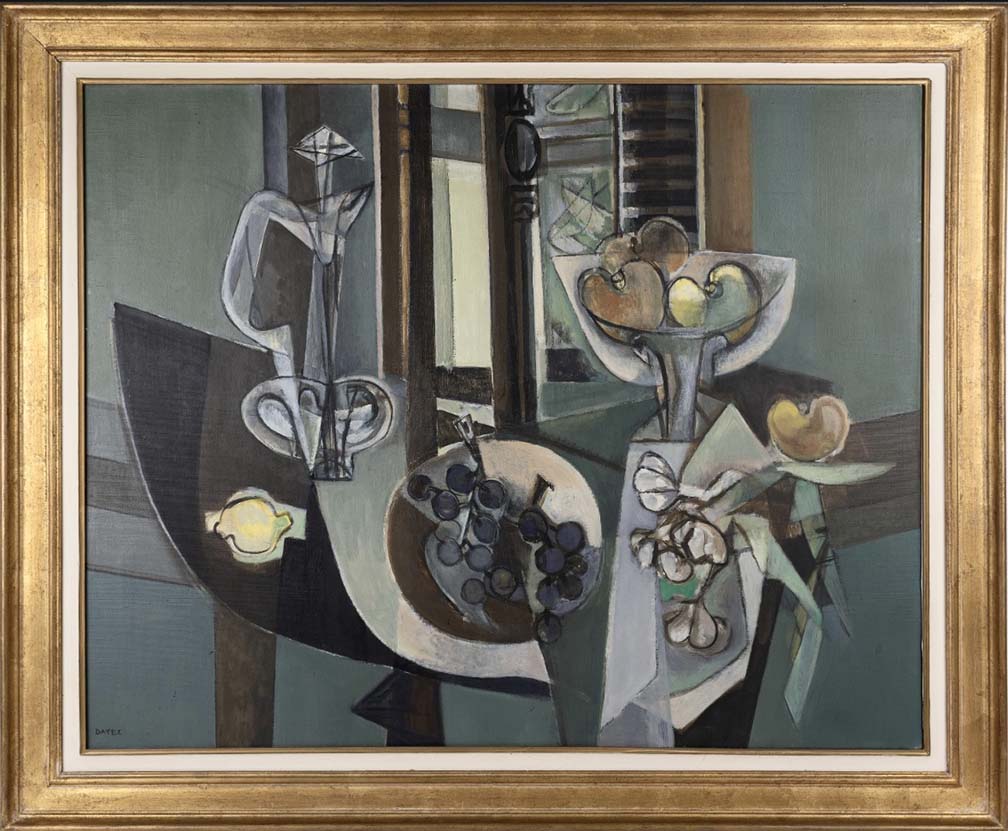

GORGEZ DAYEZ
"LE CARAFE DE CRYSTAL"
OIL ON CANVAS, SIGNED
FRENCH, DATED 1956
28.75 X 36.25 INCHES
SOLD
Georges Dayez 1907-1991 Georges Dayez was born on July 29, 1907. His father Jules was a commercial printer. In 1909, the Dayez family moved to Vaires-sur-Marne. Dayez’s father fought with the French army during World War I, while the family hid in Bayeux. Dayez received a traditional French education and was introduced to drawing and painting. He completed the first part of his baccalaureate in 1924. Much to his father’s dismay, Dayez interrupted his studies to pursue oil painting. In 1925, he worked with his father in the print shop and took an evening drawing class taught by the sculptor Henry Arnold. His classmates include other emerging painters and sculptors: Brayer, Humblot, Adam, Corbin, and Raymond Martin. Dayez could not afford tuition at the academies of Montparnasse, so Lucien Simon let Dayez audit his class during 1926. Dayez attended classes in the morning and then worked at his father’s print shop. Dayez completed his mandatory military service from 1927 to 1929. He was given special permission to attend a night class at Robert Wlérick’s studio where he met Edouard Pignon. In addition to the art class, the military allowed Dayez a leave of absence to paint in Brittany. Discharged from military service in 1929, Dayez moved to his first studio on the heights of Belleville in Paris. Pignon moved to nearby Billancourt and the two young artists painted together, studied art and visited museums. 1931, Dayez and Pignon traveled around the Côte d’Azur. The following year, both artists exhibited in the Salon des Indépendants. Dayez and Pignon joined Henri Barbusse, painters Hélion and Herbin, sculptor Adam, the October Group, as well as the writers Dabit and Nizan, and the poets Aragon and Eluard to form l’Association des Ecrivains et Artistes Révolutionnaires (A.E.A.R.). The goal of the organization was to create an art form that conveyed the struggles of the working class. The collective’s objective was to address the rise of fascism and the threat of war. With the onset of World War II, Dayez joined the French 58th Infantry Division; he was stationed north of Metz. In 1941, Dayez met French artist André Lhote who greatly influenced the development of his work. Beginning in 1944 Dayez exhibited regularly in the Paris Salons. He showed in the Salon d’Automne and the Salon des Artistes Indépendants. He exhibited in the first Salon de Mai in 1945 and became a member of the committee in 1950. During the 1950s, he exhibited at the Musée de Grenoble and Museum of Modern Art in San Francisco as well as another exhibition in Munich. Dayez exhibited numerous solo exhibitions of his work during the 1950s and 1960s. The cities were he exhibited include; New York, Lausanne, Nancy, Oslo, Amsterdam, Lyon, Avignon, Milan and Madrid, among others. During the 1951-52 academic year, Dayez taught at l’Académie d’André Lhote. In 1967 he was named a professor at l’Atelier de Lithographie de l’École des Beaux-Arts de Paris. Dayez traveled extensively during this period. He visited Italy, Greece, and the United States. He made a sojourn to Argenteuil, the birthplace of Georges Braque whose work Dayez greatly admired. Jacques Duchateau wrote the catalog essay for the 1967 exhibition “Dayez” at the Musée de Pooches, Paris. Dayez’s work is found in the collections of numerous museums, including: La Chaux-de-Fonds, Göteborg, Tolède, Le Havre, Luxembourg, Finlande, Paris, Skoplje, and Tokyo. Dayez died in 1991. |